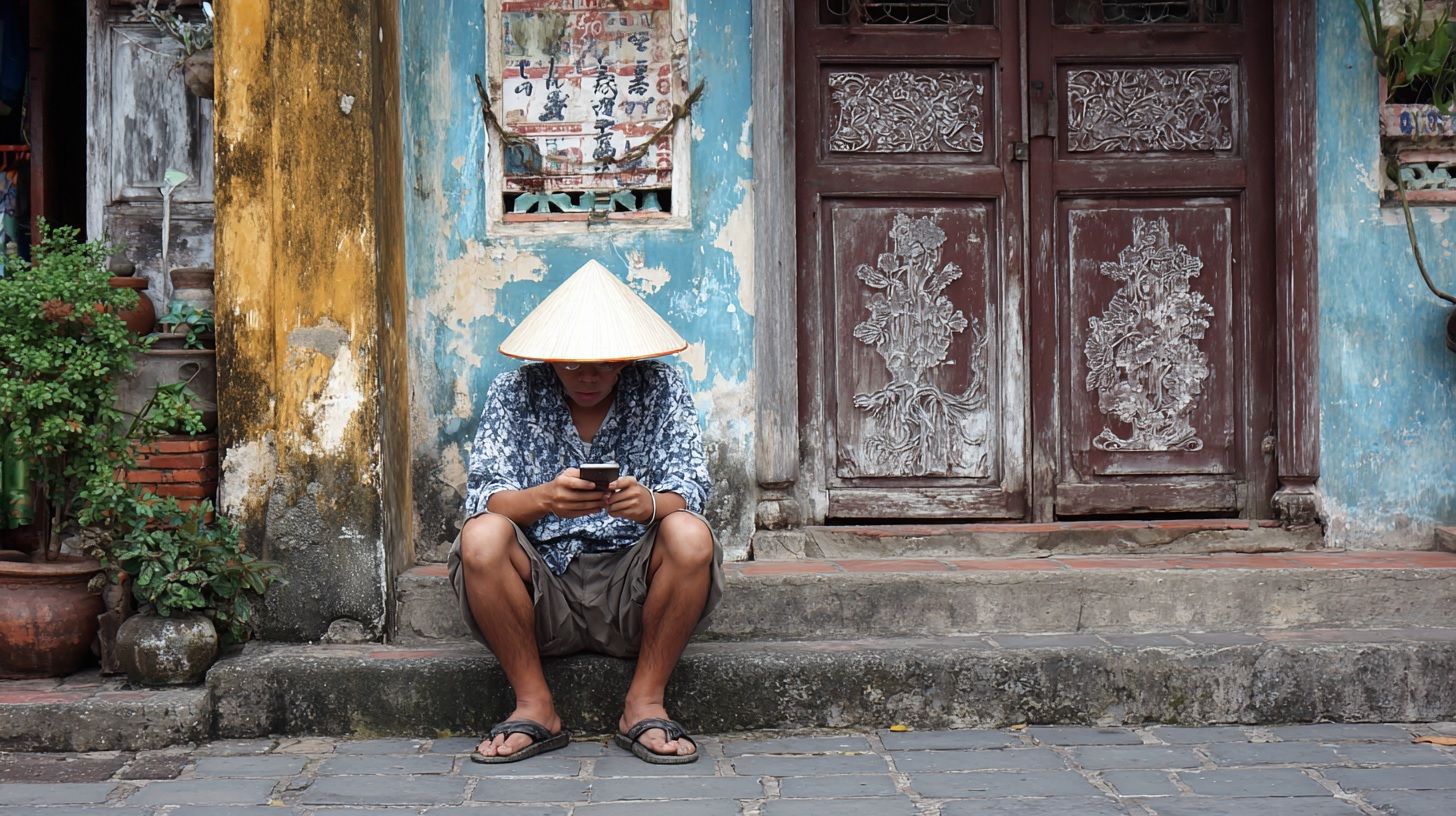- As of mid-2024, 82.2% of fixed broadband households in Vietnam were connected via fiber-optic FTTH, with universal fiber access targeted by 2025 under the Digital Infrastructure Strategy.
- 4G LTE coverage reaches 99.8% of the territory, with about 168.5 million mobile subscriptions (roughly 170% of the population) and 91.9 mobile broadband subscriptions per 100 people by mid-2024.
- Commercial 5G service launched in October 2024, with 5G base stations in all 63 provinces by late 2024 and targets of over 50% of the population by 2025 and 99% by 2030.
- International connectivity has been fragile due to undersea cables, with 4 of 5 cables malfunctioning simultaneously in late 2022–early 2023, prompting plans for at least 3 new submarine cables by 2025 and a total of about 10 cables serving Vietnam by 2025.
- In February 2025, Vietnam approved a five-year Starlink pilot allowing SpaceX to operate with no foreign-ownership cap, a 600,000-subscriber limit, a required local gateway and data localization, and licensing to be issued.
- Vietnam’s digital economy accounted for about 16.5% of GDP by end-2023 and about 18.5% by mid-2024, with a goal of 20% by 2025 and around 30% by 2030.
- The market is dominated by Viettel, VNPT, and Mobifone in mobile, with Viettel holding about 52–56% of mobile subscriptions in 2022, and Viettel, VNPT, and FPT together accounting for roughly 95% of fixed broadband.
- As of 2023, basic mobile data costs around $2 per month, entry fixed fiber plans of 30–40 Mbps cost about $10 per month, unlimited mobile data around $8–9, and premium fiber 500 Mbps–1 Gbps plans typically $15–$20 monthly.
- Vietnam is a regional IPv6 leader, with about 57% of users able to access IPv6.
- There are 12 active data centers in Vietnam, with the government planning large-scale green data centers and AI computing centers domestically by 2030 to strengthen digital infrastructure.
Vietnam’s internet landscape has transformed dramatically over the past decades, evolving from dial-up connections in the 1990s to today’s fiber-optic networks and upcoming satellite services. This report provides a comprehensive overview of internet connectivity in Vietnam as of 2023–2025, covering the infrastructure backbone, usage patterns, key players, government policies, costs and speeds, challenges, innovations, and how Vietnam compares with its regional neighbors.
Overview of Vietnam’s Internet Infrastructure
Fiber-Optic and Fixed-Line Networks: Vietnam has made fiber-optic broadband the cornerstone of its fixed internet infrastructure. In recent years, legacy copper ADSL lines have largely been replaced or bypassed by fiber-to-the-home (FTTH) services in urban areas. As of mid-2024, 82.2% of households using fixed broadband were connected via fiber-optic cable, indicating the dominance of FTTH technology. This reflects concerted efforts by providers to expand high-speed fiber access nationwide. The government’s Digital Infrastructure Strategy 2025 explicitly targets universal fiber availability: by 2025, every household is envisioned to have access to fiber-optic internet. Major cities like Hanoi and Ho Chi Minh City boast extensive fiber networks, and even many smaller provinces are now reached by fiber backbones. Digital cable and DSL broadband still exist in some locales, but they form a shrinking portion of subscriptions as fiber rollout continues.
Mobile Broadband (3G/4G/5G): Vietnam’s vast geography and large rural population make mobile broadband critical for nationwide coverage. The country has achieved near-ubiquitous mobile network reach. Fourth-generation (4G LTE) coverage reaches 99.8% of Vietnam’s territory, effectively blanketing urban and rural areas with mobile internet access. The number of cellular mobile connections (2G/3G/4G) actually exceeds the population – early 2024 counts show 168.5 million mobile subscriptions, equivalent to ~170% of the population (many people use multiple SIMs/devices). Most of these are data-enabled: by mid-2024 Vietnam recorded 91.9 mobile broadband subscriptions per 100 people, crossing the 90% milestone for the first time. In practice, this means nine out of ten Vietnamese have a 3G/4G data subscription, a remarkable penetration of mobile internet.
5G Rollout: Fifth-generation networks are at an emerging stage but expanding fast. Vietnam conducted 5G trials as early as 2019, and commercial 5G service officially launched in October 2024. By the start of 2023, pilot 5G signals were available in 40 provinces and cities, mainly in parts of Hanoi, Ho Chi Minh City, and tech hubs. In 2024, coverage accelerated after successful spectrum auctions in the 2.6 GHz and 3.5 GHz bands. Major carriers have switched on 5G base stations in all 63 provinces by late 2024, aiming to cover over 50% of the population by 2025 and 99% by 2030. While current 5G availability is mostly limited to city centers and industrial parks, the long-term goal is nationwide high-speed wireless coverage. The government has even stated an ambition to achieve full 5G coverage by 2025, though this is an aspirational target.
International Connectivity: Vietnam connects to the global internet primarily via undersea fiber-optic cables landing on its coast. This international infrastructure has been a perennial weak point – the country relies on a handful of major submarine cables (such as AAG, APG, IA, etc.), which have suffered frequent outages. Notably, in late 2022 and early 2023, 4 out of 5 undersea internet cables malfunctioned simultaneously, severely disrupting international traffic. These incidents highlighted the fragility of Vietnam’s external bandwidth. As stopgaps, providers rerouted traffic overland through neighboring countries (China, Cambodia, Thailand), but users experienced slowdowns. In response, Vietnam is racing to strengthen this backbone: the government approved plans to lay at least 3 new submarine cables by 2025 [1]. Two new cable routes were expected to go online by end of 2023 [2], and by 2025 a total of 10 undersea cables should serve Vietnam (up from 7 in 2022). This redundancy, along with landing stations in multiple regions, is intended to make connectivity more resilient to outages. In addition, Vietnam has national satellite telecommunication systems (VINASAT satellites) and cross-border terrestrial fiber links, but undersea cables carry the bulk of international data.
Internet Exchange and Data Centers: Domestically, Vietnam has a growing internet infrastructure ecosystem. There are currently 3 major Internet Exchange Points (IXPs) in the country, where ISPs interconnect and cache content. These exchanges are crucial for localizing traffic and improving speeds. However, only about 31% of the most accessed websites have a local cache or server in Vietnam (the rest require international access), which is below the Internet Society’s recommendation and suggests room for improvement in local content hosting. Data center capacity is also expanding: Vietnam hosts 12 active data centers, and the government is promoting new large-scale “green” data centers and cloud infrastructure by 2030 to support the digital economy. This includes establishing AI computing centers and ensuring government data is stored domestically.
In summary, Vietnam’s internet infrastructure today rests on robust last-mile fiber and mobile networks, complemented by ongoing 5G upgrades and backed by efforts to fortify international gateways. This blended approach – fiber for high-capacity access and mobile for reach – has dramatically increased the nation’s connectivity in both cities and countryside.
Internet Penetration and Usage Across Regions
Internet usage in Vietnam has skyrocketed, reaching the majority of the population. As of early 2024, approximately 78.4 million people are online, about 79% of Vietnam’s 99 million inhabitants. By February 2025, the figure was around 80 million users (out of 100 million population) – a stark leap from just a decade ago when less than 40% had internet access. This penetration rate places Vietnam above the global average and signifies that four in five Vietnamese enjoy internet connectivity in some form.
Urban vs. Rural Divide: Notably, internet adoption is high not only in cities but increasingly in the countryside. Vietnam’s population is still about 60% rural, with many living in remote or mountainous areas, yet the urban-rural digital gap has narrowed. Back in 2020, 82% of urban residents and 64% of rural residents were internet users. This 18-point gap has since reduced as mobile networks and affordable smartphones penetrate villages. The Ministry of Information and Communications reported that by end of 2022, 73.2% of the total population used the internet daily, implying many rural users have come online. In fact, analysts note Vietnam’s relatively high overall penetration has led to “low disparities based on geographic region” – meaning that while cities still have more coverage and options, basic internet access is reaching most communities.
That said, challenges remain in the most remote pockets. Ethnic minority villages in mountainous provinces – where extreme poverty persists – are among the last frontiers for connectivity. In these areas, even if 4G signals exist, some households lack smartphones or find service costs burdensome. The government’s Universal Service programs and telecoms’ rural outreach are targeting such gaps, via measures like free Wi-Fi at public centers and low-cost data plans for poor communities. Overall, however, the trend is one of inclusive growth: internet access is no longer a luxury of the urban elite but a mass-market utility across Vietnam.
How Vietnamese Access the Internet: The vast majority of users access the internet via mobile devices. There are over 100 million smartphone users in Vietnam (100.7 million as of mid-2024), meaning virtually all adults and even many teens own internet-capable phones. Mobile data traffic dominates, thanks to inexpensive data plans (more on pricing below) and the convenience of smartphones. Alongside mobile, fixed broadband in homes and offices is also growing: Vietnam had about 23 million fixed broadband subscriptions by mid-2024, translating to 23.5 subscribers per 100 people. Many urban households now have a fiber broadband line (often in addition to mobile data). Indeed, some 80+% of Vietnamese households with internet are connected via fiber, enjoying the faster and more stable service that FTTH provides for activities like streaming and remote work.
Internet usage patterns reflect a young, digitally savvy population. Vietnam’s median age is early-30s, and the country has over 70 million social media users. Popular activities include using Facebook, Zalo (a domestic messaging app), YouTube, and TikTok, as well as e-commerce shopping on platforms like Shopee or Lazada. A typical Vietnamese internet user now spends roughly 6–7 hours online per day, including several hours on social media. The pandemic years accelerated digital adoption in education, banking, and government services, changes which have largely persisted. From farmers using smartphones to check commodity prices, to fishermen connecting at sea via mobile internet, the online population cuts across age, gender, and geography. Encouragingly, Vietnam has achieved gender parity in internet use (women use the internet at similar rates to men), and initiatives are ongoing to ensure no group is left offline.
Key Providers and Market Share
Vietnam’s telecom market is dominated by a handful of large players, led by state-owned or affiliated companies. The big four providers each have distinct strengths:
- VNPT (Vietnam Posts and Telecommunications Group): VNPT is the incumbent state-owned telecom conglomerate. Through its subsidiary Vinaphone, it provides mobile services, and it also operates the country’s oldest fixed-line telephone and broadband network. VNPT has a stronghold in fixed broadband and landline services inherited from the days of the postal telephone system. It remains a leading broadband provider with roughly 38–39% market share in the fixed-line internet segment. VNPT’s Vinaphone is also the second-largest mobile operator. In 2021 Vinaphone (VNPT) held about 23.8% of mobile subscriptions. The company’s extensive fiber infrastructure and nationwide reach (even on islands) make it a backbone of Vietnam’s connectivity.
- Viettel: Viettel, owned by the Ministry of Defense, is Vietnam’s largest telecommunications company. It entered the market in the 2000s and quickly rose to the top, especially in mobile. As of 2022, Viettel commands over half of the mobile market (around 52–56% of subscriptions), giving it by far the widest mobile customer base – nearly 60 million mobile users. Viettel has leveraged its military roots to build infrastructure even in rugged areas, achieving extensive coverage. It also invested heavily in fiber broadband; by 2020 it had become the number one fixed broadband provider with about 39–40% share, neck-and-neck with VNPT. Viettel’s consumer brand is known for affordable data packages and it often leads in introducing new technologies (it was first to trial 5G in Vietnam and has even developed some 5G equipment in-house). Viettel also operates in several foreign markets, but domestically it’s the giant in both mobile and fixed internet, sometimes dubbed Vietnam’s equivalent of Verizon/AT&T.
- FPT Telecom: Part of the private FPT Corporation (an IT and telecom conglomerate), FPT Telecom is the prominent non-state player in the internet service market. FPT built its name in the 2000s with ADSL broadband and later pivoted to fiber. It focuses on urban and high-end residential customers, offering fast fiber plans and IPTV services. FPT’s market share in fixed broadband has grown steadily – it held about 15.6% of the broadband market in 2020 and by some estimates around 20% by 2022. That makes it the third-largest fixed broadband provider. FPT is known for good customer service and was a pioneer in providing unlimited fiber plans in Vietnam. However, it does not have a mobile network (aside from some MVNO attempts), so it’s primarily a fixed-line ISP. In recent years, FPT has expanded fiber to smaller cities and partnered with content providers for better streaming delivery.
- Mobifone: Mobifone is the other state-owned mobile operator, formerly part of VNPT before being split off. It is the third-largest mobile carrier with about 18–19% of mobile subscribers as of 2021. Mobifone has a strong brand and was historically the first GSM mobile provider in Vietnam, but it lacks a fixed-line broadband business. Its focus is purely mobile services (voice/data). Mobifone competes with Vinaphone for the second spot in many provinces. While profitable, its market share has been relatively static, and it has been slower to roll out 4G compared to Viettel. Mobifone is, however, part of government plans to deploy 5G and has been testing the technology in major cities.
Together, these four account for the lion’s share of Vietnam’s internet connectivity. For instance, Viettel, VNPT (Vinaphone), and Mobifone collectively control over 90% of the mobile market. In fixed broadband, Viettel, VNPT, and FPT combined hold almost the entire market (around 95%). A few smaller players exist: Vietnamobile (a smaller GSM operator focusing on budget users) and Gmobile (a tiny mobile network) serve niche segments but struggle to compete with the coverage and resources of the big three mobile operators. On the fixed-line side, local cable TV companies like SCTV or smaller ISPs (e.g., CMC Telecom) have limited regional footprints. Essentially, Vietnam’s telecom sector is an oligopoly dominated by state-run giants (Viettel, VNPT, Mobifone) and one major private firm (FPT).
The dominance of state-owned carriers means the government has significant influence over the telecom sector’s direction. It’s often observed that new entrants face informal barriers to entry – without political connections or significant capital, it’s hard to break into this market. Nevertheless, competition among the existing big players has driven improvements: Viettel and VNPT routinely vie to offer faster fiber or wider 4G coverage, and all operators have been cutting prices over time. From the consumer perspective, coverage is quite comprehensive and service options are expanding, but there is relatively little diversity in ownership of the infrastructure (most of it traces back to the state or military). This dynamic shapes the regulatory environment and investment patterns, as we’ll see next.
Government Policies, Digital Goals, and Regulation
The Vietnamese government plays a central role in the development and regulation of internet access. Overall, the state’s approach marries ambitious digital growth targets with a tight grip on infrastructure and data control.
National Digital Transformation Program: Vietnam’s leadership views the digital economy as a key driver of future growth. In June 2020, the Prime Minister approved a National Digital Transformation Programme through 2025, with orientation to 2030, which lays out concrete connectivity and digital adoption goals. Under this strategy, by 2025 Vietnam aims to: have all households access broadband (as noted, fiber to every home), all communes connected by high-speed internet, e-governance platforms in place nationwide, and a certain proportion of services moved online. There is also a target for the digital economy to make up 20% of GDP by 2025 and around 30% by 2030. To push these goals, the government formed a high-level National Committee on Digital Transformation in 2021 chaired by the PM himself, underscoring top-down commitment. Digital transformation is woven into Vietnam’s socio-economic development plans, with buzzwords like Industry 4.0, smart cities, cashless payments, and e-government being emphasized.
Infrastructure Investment and Incentives: To achieve these objectives, authorities have ratified strategies such as the “Digital Infrastructure Strategy to 2025”, which we touched on earlier. Key targets from this include: “by 2025, all localities (provinces), hi-tech parks, R&D centers, industrial parks, major transport hubs will have 5G coverage” – effectively ensuring that even if full nationwide 5G isn’t done by 2025, all key areas will be covered. Another notable goal is to put into operation at least two new international undersea cables by 2025 to boost external bandwidth and reduce the chronic dependence on a few cable systems. The strategy also encourages building hyperscale data centers and domestic cloud platforms, reflecting Vietnam’s desire for data sovereignty and capacity to handle the exploding data usage. By 2030, 5G coverage is officially targeted to reach 99% of the population, and Vietnam aims to rank among the top 50 countries globally in e-government and digital economy indices. These are bold goals, and ministries are funneling investments accordingly, often in partnership with the quasi-state telecom firms (for example, Viettel has been assigned to spearhead 5G equipment R&D and VNPT to focus on digital government platforms).
Regulatory Environment: The regulatory regime for telecoms is overseen by the Ministry of Information and Communications (MIC), with input from the Ministry of Public Security (for security/censorship matters). Formally, Vietnam allows multiple ISPs to operate, but in practice the state maintains control over critical infrastructure. VNPT and Viettel, being state-run, operate the key Internet Exchange Points and backbone networks, which means the government can influence traffic routing and, if needed, intervene in connectivity. Indeed, all internet gateways ultimately fall under state oversight, enabling authorities to enforce blocks or slowdowns for political reasons. One example: in 2020, Vietnam temporarily throttled Facebook’s local servers, causing the platform to slow to a crawl nationwide until Facebook agreed to stricter content moderation [3]. While outright internet shutdowns are not common, this incident showed the leverage authorities have via infrastructure choke points. Vietnam also has a cybersecurity law (effective 2019) that requires online data on Vietnamese users to be stored on local servers and allows content takedowns – indicating the policy of “network sovereignty.”
For new services, regulations can be stringent. Foreign ownership in telecom services has traditionally been capped (usually at 49%), as telecom is considered a sensitive sector. This is why the government’s recent openness to foreign satellite internet (like Starlink) is so noteworthy (discussed in the Satellite section). In broadcasting and OTT media, new decrees mandate foreign players to partner with local firms or face licensing barriers. All these policies point to a carefully managed digital ecosystem: the government welcomes innovation and investment that align with national goals, but insists on local control, data residency, and the ability to regulate content.
Digital Government and Services: On the public services front, Vietnam has been pushing e-government strongly. By 2023, most public administration services (from tax filing to business registration) have online portals. The aim is to have Vietnam in the top 3 ASEAN countries for e-government by 2030. The country launched a National Public Service Portal and is developing a digital ID system for citizens (with a target of over 50% of adults having a digital identity or signature by 2025). During the COVID-19 pandemic, apps like Bluezone and online vaccination portals were rolled out, further habituating citizens to digital interactions with government.
Digital Economy Ambitions: Vietnam’s digital economy – which includes e-commerce, fintech, ride-hailing, online media, etc. – is booming under these supportive policies. By end of 2023, the digital economy contributed about 16.5% of GDP, up from around 12% in 2020. By mid-2024 it reached an estimated 18.5% of GDP. This growth (over 20% annually in 2023) has made Vietnam one of the fastest-growing digital economies in Southeast Asia. The government’s goal of 20% GDP by 2025 seems within reach at this pace. Notably, Vietnam’s digital economy is now roughly on par (in GDP share) with Thailand’s and only behind Singapore and Malaysia in ASEAN. A Google/Temasek report cited by the government showed Vietnam’s internet economy grew 28% in 2022 and 19% in 2023 despite global headwinds – covering everything from online retail and digital banking to the IT outsourcing industry. To maintain this momentum, policies are encouraging e-payments (cashless transactions) and supporting tech startups. The country has minted several “unicorn” startups in e-commerce and gaming.
In short, Vietnam’s policy framework balances growth with control. The state is investing heavily in expanding internet access and reaping the benefits of digitization, but it also maintains strict regulatory oversight to steer the digital domain in line with socialist orientation and national security concerns. For users and businesses, this means excellent improvements in access and service availability, albeit within an ecosystem closely watched by authorities.
Pricing, Speeds, and Affordability
Internet access in Vietnam is not just widespread – it’s also relatively affordable and improving in quality year by year. Low costs and rising speeds have helped drive the high usage rates observed.
Costs and Affordability: Vietnam enjoys some of the cheapest data prices in the region. As of 2023, a basic monthly mobile data plan costs as little as $2 USD (around 50,000 Vietnamese đồng), which might include a few GB of 4G data – enough for basic social media and browsing. On the fixed broadband side, entry-level fiber plans (with speeds of 30–40 Mbps) are available for about $10 USD per month (~240,000 VND). For context, Vietnam’s average monthly income in 2022 was roughly $283, so these internet plans represent only a small fraction of household income for most families. Indeed, a study by the Internet Society found that just 1.15% of GNI per capita is needed to pay for a basic mobile internet package in Vietnam, well under the UN affordability target of <2% of income. This has made internet access broadly affordable, even in rural areas, and price is seldom a barrier except for those in extreme poverty. Telecom companies, under government pressure, have kept tariffs low and often run promotions (e.g. free data days, bonus top-ups) to attract users.
Higher-tier packages exist too: for example, unlimited mobile data packages cost around 200,000 VND/month ($8–9), and premium fiber broadband plans (e.g. 500 Mbps or 1 Gbps for home use) might run in the $15–$20 range monthly – still quite cheap by global standards. Such pricing has led to healthy competition where a consumer in Hanoi can choose between VNPT, Viettel, or FPT fiber offerings that are both fast and inexpensive. Overall, internet service in Vietnam is considered a good value, and falling prices over the past decade have continually brought more people online.
Internet Speeds: Once infamous for sluggish speeds, Vietnam has significantly improved its internet performance. According to Ookla’s Speedtest Global Index, by the start of 2024 Vietnam’s average connection speeds were: ~105 Mbps median download on fixed broadband, and ~47 Mbps median on mobile. These represent substantial jumps from a year prior – fixed broadband speeds increased over 30% during 2023, and mobile speeds about 19% as 4G networks densified. The Freedom House report noted that by May 2023, Vietnam’s median mobile download was 47.27 Mbps and median fixed download 93.3 Mbps, which align with the DataReportal figures for early 2023. By late 2024, speeds have climbed further with the expansion of fiber and initial 5G deployments.
To put the numbers in perspective, a mobile download speed around 40–50 Mbps is sufficient to stream HD videos or have smooth video calls, and Vietnam’s median is now above that threshold. Fixed broadband at 100+ Mbps means many urban users enjoy very fast home internet – streaming 4K videos, online gaming, and large file transfers are easily handled. Vietnam’s broadband speeds rank among the top 40 countries globally now, a notable achievement for a developing economy. In fact, Vietnam is 35th worldwide for fixed broadband speed and 37th for mobile speed as of 2024, according to one ranking. This puts it ahead of some European countries and on par with its more developed Asian neighbors in terms of raw speed.
Speed improvements come from the heavy shift to fiber (FTTH has much higher capacity than old ADSL or cable) and continuous investment in network upgrades by the big providers. Viettel and VNPT have been racing to offer gigabit fiber in major cities. Additionally, Vietnam’s high adoption of IPv6 (57% of users can access IPv6) [4] helps improve network efficiency and speed for newer services. The upcoming widespread 5G will further boost mobile speeds – early 5G trials in Hanoi have demonstrated over 1 Gbps on mobile in ideal conditions, though typical 5G user speeds will likely be in the 100–300 Mbps range once fully deployed.
Comparing Across Income Levels: Because basic internet is affordable, the main differentiator in service quality is how much one is willing or able to pay. Lower-income users may stick to the $2 mobile plans with limited high-speed data (after which speed is throttled), while higher-income households might pay for 100 Mbps fiber plus a generous mobile plan. However, even the cheapest options deliver decent connectivity – for example, VNPT’s lowest-cost home fiber plan (~$7/month) offers 30 Mbps unlimited, which is enough for a small family’s needs. Surveys indicate that internet access is now within reach of the vast majority of Vietnamese, with cost being a minor factor relative to device availability and digital literacy. There remain some households in remote areas for whom even $2/month is a stretch, but there are government programs and telecom CSR initiatives to address those (such as providing free public Wi-Fi hotspots and subsidized service in poverty-stricken communes).
In summary, Vietnam’s internet is not only fast and getting faster, it’s also cheap. The combination of falling price-per-megabit and rising incomes has made internet connectivity an afterthought in many household budgets, fueling further uptake.
Challenges in Connectivity: Geography, Infrastructure, and Politics
Despite the impressive progress, Vietnam faces a set of challenges in ensuring reliable and equitable internet access. These challenges are rooted in the country’s geography, existing infrastructure limitations, and political/regulatory choices:
- Geographical Obstacles: Vietnam’s topography includes long coastlines, densely forested mountains (especially in the north and central highlands), and thousands of islands. Providing last-mile connectivity to remote or rugged regions is costly and logistically difficult. While 4G signal may officially cover 99%+ of the territory, the quality of that signal in deep valleys or far-flung hamlets can be weak. Mountainous provinces with dispersed ethnic minority villages often have only one base station covering a large area, resulting in spotty mobile data coverage. Laying fiber to such villages is even harder – the cost per connection in remote rural areas is very high, and operators must sometimes string cables over mountains or rely on microwave backhaul. The government has identified around 2,000 villages that still lack cellular coverage or internet, usually very small communities. Power supply can be an issue too: some rural communities not fully on the electric grid obviously can’t sustain telecom equipment continuously. Although small in percentage terms, these pockets of coverage gaps are a challenge to Vietnam’s goal of 100% digital inclusion.
- Undersea Cable Fragility: As discussed, Vietnam’s international connectivity has a single point of failure problem – heavy reliance on a few undersea cables that break frequently. Incidents in recent years have shown Vietnam’s internet to be “mỏng manh” (fragile) in the face of cable cuts. When cables snap (due to earthquakes, ship anchors, etc.), users experience slowdowns accessing foreign sites, sometimes for weeks. The simultaneous outage of multiple cables in early 2023 was unprecedented and caused nationwide disruption. These episodes spark public frustration and highlight the need for more resilient infrastructure. To tackle this, Vietnam is hurrying to diversify its international links – laying new submarine cables, and even exploring overland fiber routes through Laos, Cambodia, Thailand to connect to other subsea cable systems. Until these new cables (like ADC, SJC2, etc.) are operational, Vietnam will remain somewhat vulnerable. The interim solution of rerouting traffic via neighboring countries helps but is not as high-bandwidth as direct cables. In short, ensuring stable high-speed international access is an ongoing challenge; any improvements in domestic network speed can be undermined when a cable fault throttles global connectivity. The planned addition of two new undersea routes by 2025 should alleviate this issue if executed on time [5].
- Last-Mile Infrastructure and Quality: Within cities, infrastructure challenges include overloaded networks in dense areas. In big cities like Ho Chi Minh City, there are reports of fiber congestion in some apartment complexes, or mobile network slowdowns in crowded downtown districts during peak hours. Carriers need continuous upgrades (more fiber backhaul, small-cell deployments for 4G/5G) to maintain quality of service as data demand grows ~30% year-on-year. Another infrastructural challenge is old, tangled telecom poles and ducts in cities – it’s common to see clusters of overhead cables on streets, which can be risked by storms or simply degrade. The government has been pushing for underground cabling projects to tidy up and protect telecom lines, but this is a gradual process.
- Digital Literacy and Content Barriers: On the human side, there’s the challenge of ensuring all new users know how to use the internet effectively. Many rural or older users lack digital literacy – they may have a 4G connection but not know how to do more than basic calling and Facebook. There are ongoing education programs to teach digital skills in communities. Language is another barrier: a large portion of global web content is in English, while many Vietnamese (especially older generations) are not fluent in English. The Vietnamese-language internet (news, entertainment, government services in Vietnamese) has grown, but ensuring relevant local content for rural users (e.g. farming techniques, healthcare info in Vietnamese or minority languages) is important.
- Political and Regulatory Constraints: Vietnam’s government exercises close control over internet infrastructure, which can sometimes conflict with openness or rapid innovation. For instance, any new telecom service or major foreign investment must navigate regulatory approval that may be slow or subject to political considerations. The limited diversity of service providers – with the big state-affiliated firms dominant – means there is less market-driven pressure to serve low-profit areas or improve customer service in some cases. Smaller would-be competitors are often discouraged by the playing field. Moreover, the government’s tight grip can manifest in active measures: in times of social unrest or sensitive political events, authorities have been known to throttle internet traffic or block social media (albeit usually temporarily) [6]. This creates an environment where connectivity can be curtailed for security reasons, a challenge for freedom of access. Vietnam ranks low on Freedom House’s internet freedom index in part due to these controls.
- Cybersecurity and Spam: As millions have come online, issues like malware, phishing, and online scams have grown. Vietnam has sometimes been cited as a source of high volumes of spam or cyber-attacks (some linked to hacker groups). Ensuring secure connectivity and user trust is another challenge – the government has passed cybersecurity laws and stepped up monitoring, but cyber education for users is still catching up.
In summary, connecting the unconnected rural minority, fortifying the network against disruptions, and balancing state control with user demands for open, fast internet are Vietnam’s key connectivity challenges. The government and telcos are actively addressing many of these (e.g., infrastructure investment, rural outreach), but some – like undersea cable breakages or political censorship – remain as underlying issues in Vietnam’s internet narrative.
Satellite Internet: Starlink’s Entry and the Race to the Skies
One of the most exciting developments on Vietnam’s connectivity horizon is the advent of satellite internet services. In particular, Elon Musk’s Starlink, the low Earth orbit (LEO) satellite constellation, has generated buzz about bringing connectivity to remote parts of Vietnam – but its journey into the country has been careful and conditional.
Status Quo Ante: Traditionally, Vietnam has relied on geostationary satellites (like VINASAT-1 and -2) for certain telecommunication needs (e.g., broadcasting to far islands, military comms), but satellite internet for consumers was virtually nonexistent. High latency and cost made older satellite options unviable for general internet access. Plus, regulatory policy disallowed foreign satellite services from directly providing service in Vietnam without a local license. In fact, until recently, Starlink was effectively banned or unlicensed – any use of Starlink terminals was technically illegal under Vietnamese law, which mandates government control over telecom services.
Regulatory Breakthrough in 2023–2025: This stance shifted dramatically in early 2025 due to a combination of diplomatic and strategic factors. In February 2025, Vietnam’s National Assembly approved a pilot scheme to allow satellite internet operators like SpaceX (Starlink) to operate in Vietnam, provided certain conditions are met. The government had been in talks with SpaceX since 2022, but negotiations sped up in late 2024 as Vietnam sought to attract U.S. high-tech investments. The breakthrough came when Vietnam agreed to waive the normal foreign-ownership restrictions for this pilot – essentially letting SpaceX run the service while partnering locally, a significant concession in a “sensitive” sector. In return, SpaceX must abide by Vietnam’s requirements on data control and censorship (more on that below). Prime Minister Phạm Minh Chính personally pushed for quick licensing of Starlink, signaling high-level support. By March 2025, the government announced it would rapidly issue a license for Starlink to operate on a trial basis.
Sure enough, on March 23, 2025, the Vietnamese government greenlit a five-year pilot program for SpaceX’s Starlink service. This pilot, under Ministerial Decision No. 659, allows SpaceX to deploy LEO satellite internet across Vietnam, without any cap on foreign ownership of the service locally. Such an allowance is extraordinary – it essentially lets SpaceX bypass the typical joint-venture requirement and run the show, acknowledging that Starlink’s model doesn’t easily accommodate local control. However, the pilot comes with strict conditions to satisfy Vietnam’s defense and cybersecurity concerns:
- Local Gateway and Data Localization: SpaceX must establish a ground gateway station in Vietnam before beginning service. All Vietnamese user traffic must route through this domestic gateway, integrating into the national telecom network. In effect, this ensures the government can monitor and regulate the Starlink traffic like any ISP. Additionally, user data originating in Vietnam must be stored on local servers, per the country’s data sovereignty laws. These requirements mirror those imposed on terrestrial telecom providers and are aimed at preventing uncontrolled information flow via satellites.
- Content Control and Security: Starlink is obligated to implement measures to block “harmful content” and adhere to Vietnam’s cybersecurity and content regulations. In other words, Starlink’s internet feed into Vietnam cannot become a loophole for banned websites or uncontrolled social media. Technically, how a satellite provider will filter content is complex, but the ground station requirement gives a point to enforce such blocks. The Ministry of Public Security and Ministry of National Defense will oversee compliance, along with the tech ministry.
- Licensing and Timeline: SpaceX must obtain a telecommunications service license and radio frequency permit in Vietnam. Once licensed, the pilot can run for 5 years and must conclude by January 1, 2031. The clock starts when the operating license is granted (likely in 2025), so the pilot goes through ~2030 at the latest.
- Scale Limits: During the trial, Starlink is capped at serving no more than 600,000 subscribers in Vietnam. This figure includes both direct customers and those who might get Starlink service through local telecom resellers. 600k is a significant number (for comparison, that’s about 2.5% of current internet users in Vietnam), but it’s a ceiling to keep the pilot contained rather than immediately upending the market.
The allowance for Starlink is part of a broader Vietnamese policy to foster innovation and digital transformation. The pilot was enabled by National Assembly Resolution No. 193 (Feb 2025), which set special mechanisms to attract science, tech, and innovation breakthroughs. Vietnam clearly sees LEO satellite internet as an innovative complement to its connectivity mix – particularly for remote areas, marine connectivity, and aviation. Under the pilot, Starlink can provide both fixed satellite internet (for homes/offices) and mobile satellite services (for ships, boats, and aircraft in Vietnam’s jurisdiction). This suggests fishing fleets or rural schools in mountainous areas, for example, could be equipped with Starlink to get high-speed internet where fiber or cell towers can’t reach.
Starlink Trials and Prospects: Even before the official license, Starlink made small test appearances. In October 2023, a Starlink demo at the Vietnam International Innovation Expo in Hanoi showed speeds around 200 Mbps downlink, impressing attendees with its performance. This kind of speed via satellite is a game-changer for rural broadband. SpaceX’s representatives have met with Vietnamese leaders (in Sept 2024, a senior VP of SpaceX met PM Chính) and expressed commitment to invest up to $1.5 billion in Vietnam for Starlink’s rollout. This investment would likely go into the ground station, user terminals, and local operations.
Once operational, Starlink could serve as a lifeline for connectivity in Vietnam’s hardest-to-wire areas – think island communes, border regions in the mountains, or even disaster recovery scenarios when terrestrial networks are down. It can also provide connectivity on the move (e.g. long-distance buses, ships along Vietnam’s coast, airplanes) which current networks struggle with. However, the service won’t be cheap for end users: Starlink’s hardware and subscription worldwide cost much more than typical Vietnamese internet plans. We might see a model where government or businesses purchase Starlink for specific remote sites (e.g. border patrol stations, weather outposts, or rural schools) rather than mass consumer adoption initially.
Vietnam is not alone in Southeast Asia in exploring LEO satellites. Neighbors like Malaysia jumped on Starlink earlier – in mid-2023 Malaysia approved Starlink and even deployed units at rural schools to improve internet there. Indonesia too has engaged Starlink via a partnership with state-owned Telkom, though limiting it to enterprise and backhaul uses [7] [8]. Thailand has been in discussions as well. Vietnam’s cautious but eventual acceptance of Starlink shows a recognition that satellites can fill critical gaps in coverage. The controlled pilot ensures Vietnam retains oversight and can evaluate the impact before full commercialization.
Beyond Starlink, other satellite internet possibilities include OneWeb (another LEO constellation) or services from regional satellite operators. Viettel has hinted at using satellite backhaul for IoT networks in remote areas, and Vietnam’s Space Committee has talked about developing new satellite capacity. But for now, Starlink is the headline player.
In conclusion, satellite internet is poised to add a new dimension to Vietnam’s internet access, reaching places fiber and cell towers cannot easily go. With the Starlink pilot underway, Vietnam could in a few years have villagers in the deep highlands browsing at 150 Mbps via satellite – an almost sci-fi scenario coming true. The government’s balancing act will be to harness this technology for development while keeping it under the umbrella of national internet governance.
Innovations in Internet Technology and Digital Economy Ambitions
Vietnam’s internet story is not just about expanding access – it’s also about keeping up with cutting-edge tech and using connectivity to power a burgeoning digital economy. Several innovation trends and ambitions are noteworthy:
- 5G and Beyond: Vietnam is fully embracing 5G as a platform for innovation. Local telecoms have been innovative in this space – notably, Viettel developed its own 5G radio equipment and core technology in collaboration with local tech firms, seeking to reduce reliance on foreign vendors. By launching 5G commercially in 2024, Vietnam joined the early wave of countries adopting the technology. The aim is not only faster consumer mobile internet, but also enabling advanced use cases: smart factories, autonomous vehicles, telemedicine, and more. For instance, Viettel has partnered with industries to pilot 5G for IoT networks in manufacturing. The government projects over 90 million 5G connections by 2030 in Vietnam, essentially expecting most mobile users to transition to 5G over the next decade. There is even a plan to shut down 2G networks by end of 2024 to repurpose spectrum – as of mid-2024 about 11 million users still had 2G-only phones, and authorities are pushing them to upgrade so legacy networks can be retired.
- IoT and Smart Infrastructure: Hand in hand with 5G, Vietnam is pushing the Internet of Things (IoT) in various sectors. The digital infrastructure strategy calls for each citizen to have at least one IoT connection by 2025, underscoring the vision of pervasive connectivity (think smart home devices, wearables, sensors, etc.). Cities like Da Nang and Ho Chi Minh City have launched “smart city” initiatives deploying IoT sensors for traffic management, waste collection, and air quality monitoring, all reliant on stable networks. In agriculture, pilot projects use IoT for smart farming (monitoring soil, automating irrigation). Viettel and VNPT have both rolled out NB-IoT networks (a narrowband IoT on LTE) covering major urban areas to support these applications. Future 5G networks will further boost IoT with low-latency, massive device connectivity.
- E-commerce and Fintech Boom: Ubiquitous internet has catalyzed a vibrant e-commerce scene. Companies like Shopee, Tiki, Lazada, and Sendo serve tens of millions of online shoppers in Vietnam. Especially after COVID-19, online retail saw a boom; even rural users started ordering products via Facebook or Zalo. The government reported that by 2023, there were 1.5k+ Vietnamese tech enterprises earning revenue overseas, many in software outsourcing and digital services – showing the growing sophistication of the tech sector. Fintech and digital payments are another focus: mobile wallet and QR code payment adoption have grown quickly, aligning with the State Bank’s target of a cashless society. All four major mobile operators launched their own e-wallet or mobile money services after regulators allowed mobile money in 2021, aiming to bring financial services to the unbanked via internet connectivity.
- Digital Content and Creators: Vietnam’s cultural and entertainment sectors are also riding the internet wave. The country is among YouTube’s top markets by watch time; many Vietnamese content creators have large followings. The music and film industries are leveraging streaming platforms, with domestic streaming apps competing alongside Netflix. Online gaming is huge in Vietnam – local studios like VNG have become major players regionally, and Vietnam is known for its esports talent, all predicated on solid internet connections. The government, while keeping an eye on content control, encourages the growth of a local digital content industry as part of its digital economy.
- Tech Hubs and Startup Scene: Improved connectivity has underpinned the rise of Vietnam’s startup ecosystem. Cities like Ho Chi Minh City, Hanoi, and Da Nang now host numerous co-working spaces and incubators filled with startups working in e-commerce, ed-tech, blockchain, AI, etc. Vietnam’s relatively young population and growing pool of IT engineers (the country is a global hub for software outsourcing) have led to a wave of innovation. Companies like FPT and Viettel have their own research institutes focusing on AI, 5G, and cybersecurity. For example, Viettel’s R&D arm has worked on AI applications for network management and was involved in creating a Vietnamese natural language processing platform. On the policy side, Vietnam introduced sandboxes for fintech and is drafting regulations for emerging tech like AI and blockchain to foster innovation while managing risks.
- Digital Government Services: Another area of innovation is the government’s provision of services online. Vietnam’s “MyGov” mobile app and the national public service portal allow citizens to do things like apply for licenses or certificates online, track pension accounts, and more – reducing bureaucracy and requiring robust secure networks. The nation’s e-government ranking has been improving (as of 2022, the UN e-government index placed Vietnam 86th globally, up several places). By 2030 the ambition is to break into the top 50.
- Regional Leadership in Tech: Vietnam aspires to not just catch up but lead in some areas. The MIC often cites Vietnam as having “one of the highest digital potentials in ASEAN”. The country is already a leader in IPv6 adoption (over 50%), second in ASEAN only to Malaysia in that metric [9]. It’s also one of the first in Southeast Asia to pilot 5G network sharing (Viettel, VNPT, Mobifone agreed to share 5G infrastructure to accelerate rollout). Hanoi and Ho Chi Minh City routinely rank in top Asian cities for outsourcing and innovation attractiveness. By developing domestic tech capabilities and leveraging widespread internet, Vietnam aims to be a tech hub bridging the likes of Singapore and emerging markets.
Overall, Vietnam’s digital ambitions are high: leadership envisions the country becoming a fully digital society with a prosperous online-driven economy by the 2030s. The internet – fast, affordable, and accessible – is the bedrock of that vision. If current trends hold, Vietnam will continue climbing global rankings not just in number of users, but in the sophistication of its internet use and contributions to the digital world.
Vietnam vs. Regional Neighbors: A Comparative Snapshot
How does Vietnam stack up against other Southeast Asian countries in internet access and usage? The picture is generally positive for Vietnam, though with some variations:
- Internet Penetration: Vietnam’s ~79% internet penetration rate is high for its income level, but it trails Malaysia and Thailand. Malaysia is nearly fully wired – about 98% of Malaysians were online by 2023, essentially universal access in a population of 33 million. Thailand, with a mix of urban and rural similar to Vietnam, has achieved about 88% internet penetration as of 2024. Vietnam, at ~79%, is a bit behind these, though notably ahead of the regional giant Indonesia, which is around 75% penetrated (Indonesia’s vast archipelago leaves roughly 1 in 4 people still offline). In absolute numbers, Vietnam’s ~80 million internet users are fewer than Indonesia’s (~205 million users, given its larger population) but far more than Malaysia’s (~32 million users) or Thailand’s (~63 million). This makes Vietnam the 12th-largest internet user base in the world as of 2022. Growth is slowing as Vietnam nears saturation, but there is still headroom to reach the 90%+ levels of its neighbors in coming years, especially by targeting the remaining rural and elderly demographics.
- Urban-Rural Gap: Compared to countries like Indonesia or the Philippines, Vietnam has a smaller urban-rural digital divide. Indonesia’s rural connectivity is much lower, dragging its overall penetration down. Thailand and Malaysia both have higher urbanization than Vietnam and thus slightly easier paths to universal access. Vietnam’s success in narrowing the gap comes from prioritizing mobile coverage in all communes; for example, Thailand’s fixed broadband is heavily urban, but Vietnam’s mobile broadband brought many rural folks online. Freedom House noted Vietnam’s “relatively low disparities” across regions in internet access, something Indonesia and the Philippines still struggle with. This egalitarian spread is a strong point for Vietnam.
- Broadband Infrastructure: In fixed broadband, Vietnam surprisingly leads some neighbors in coverage and adoption. Vietnam has ~23.5 fixed broadband subscriptions per 100 people, whereas Thailand has about 15–16 per 100 and Malaysia ~13 per 100 [10]. This indicates Vietnam’s aggressive FTTH rollout has reached more households proportionally than in Thailand or Malaysia (which rely more on mobile broadband or still have gaps). Thailand’s absolute number of fixed lines (about 11 million in 2023) is lower than Vietnam’s (23 million) despite Thailand’s population being smaller – a notable achievement for Vietnam’s telecom sector [11]. However, Malaysia and Thailand have higher household broadband penetration when measured by households (since they have smaller households and many homes have broadband – Malaysia’s fixed broadband coverage is ~89% of households in urban areas but per-capita looks lower due to smaller population). Still, Vietnam’s policy of “fiber to all by 2025” is clearly ahead of where Indonesia is (Indonesia’s fixed broadband per 100 is extremely low, on the order of 4 or 5) and competitive with Thailand.
- Mobile Connectivity: All these countries are mobile-first internet societies. Vietnam’s mobile subscription rate (164% of population) is similar to Malaysia’s and Thailand’s which also have more SIMs than people. 4G coverage in Vietnam (99%+) is on par with Thailand (Thai operators also report ~95-98% population coverage) and better than Indonesia (where some remote islands lack coverage). 5G progress: Here Vietnam lags Malaysia and Thailand slightly in timing – Thailand launched commercial 5G in 2020 and had many cities covered by 2022; Malaysia started 5G in late 2021 via a single wholesale network (DNB) and reached around 50% population by 2023. Vietnam’s 5G launch came in 2024 and will take a couple of years to catch up in coverage. By 2025, Vietnam aims to have broad 5G, but Thailand might already be at 80%+ and Malaysia perhaps similar. Indonesia is slower, launching 5G only in select areas and it will be late 2020s for wide coverage there. So Vietnam is mid-pack in 5G timeline: not the first, but not the last in ASEAN.
- Internet Speed Rankings: When it comes to speed, Thailand is the regional champion in fixed broadband – Thai users enjoy some of the fastest fiber in the world, with median downloads over 230 Mbps [12] (Thailand ranks in the global top 10-15 for fixed speeds). Vietnam’s median ~105 Mbps, while a huge improvement, is still less than half of Thailand’s. Malaysia’s fixed broadband median is around 112 Mbps, very close to Vietnam (Malaysians on Telekom Malaysia’s unifi fiber or TIME Internet get great speeds, but Malaysia also has more slow ADSL legacy in rural parts pulling the average down). On mobile, Malaysia’s early 5G adoption actually gave it a high median mobile speed – over 100 Mbps median mobile in 2023 (one report clocked Malaysia ~107 Mbps) [13]. Vietnam’s median mobile ~47 Mbps is lower, likely because Vietnam’s data is still mostly on 4G. Thailand’s median mobile ~55 Mbps [14] is a bit ahead of Vietnam. Indonesia lags with about 29 Mbps mobile and only ~32 Mbps fixed median [15], reflecting its less developed infrastructure. So in summary: Vietnam’s internet speeds are competitive but not the fastest in ASEAN – Thailand and Malaysia outpace it in either fixed or mobile, but Vietnam is far ahead of more populous Indonesia in both speed and coverage.
- Digital Economy Size: In terms of digital economy (as % of GDP), Vietnam (16–18% in 2023) sits similar to Thailand and a bit behind Malaysia (Malaysia’s digital economy was about 23% of GDP in 2021, including manufacturing digitization). Singapore is an outlier at 30%+. But Vietnam has the fastest growth rate of digital economy in the region in recent years, meaning it could catch up if growth remains above 20% annually. For instance, e-commerce GMV in Vietnam in 2023 ($14 billion) was approaching that of Thailand ($16B) despite Vietnam’s lower GDP, according to Google/Temasek reports.
- Satellite and New Technologies: Regionally, the approach to Starlink varies. The Philippines was the first in ASEAN to approve Starlink (in 2022) and has since rolled it out to remote villages. Malaysia followed quickly in 2023, with the government even purchasing Starlink units for rural schools and allowing individuals to subscribe directly, showing a more open-arms approach. Indonesia has been cautious, only allowing Starlink through a local partner (Telkomsat) for enterprise and not retail, similar to Vietnam’s cautiousness [16] [17]. Thailand was reportedly in discussions but hadn’t publicly rolled out Starlink as of 2024. Vietnam’s decision to pilot Starlink in 2025 puts it roughly in the middle – not the earliest adopter, but now moving ahead of neighbors like Thailand that haven’t formalized it. Once again, Singapore stands apart (with ubiquitous fiber, it has little need for Starlink except maybe for maritime use).
In a nutshell, Vietnam holds its own in Southeast Asia’s internet race. It is no longer a laggard by any means – in fact, it leads in some aspects like per-capita fiber deployment. It is behind the very advanced (Singapore, Malaysia in some metrics, Thailand in speed) but ahead of or on par with countries at similar development levels (Indonesia, Philippines) in most connectivity indicators. This bodes well for Vietnam’s competitiveness and integration in the region’s digital future. The continued investments and reforms in Vietnam suggest it could further close the gap with the front-runners within a few years, especially as 5G matures and if it successfully leverages new tech like satellite internet.
Conclusion
Vietnam’s internet journey exemplifies a rapid development trajectory: from virtually no access in the mid-1990s, the country now boasts tens of millions of users, modern infrastructure spanning fiber optics to 5G, and an emerging satellite internet chapter. The current state of internet access in Vietnam is one of broad availability, improving quality, and strategic importance. Robust fiber and mobile networks connect urban hubs and rural hamlets alike, yielding a nearly 80% internet penetration and pushing the benefits of connectivity to most citizens. Prices are low, speeds are high and rising, and the digital economy is flourishing – contributing an ever-greater share to national GDP and transforming how Vietnamese live, work, and interact.
This progress stems from a mix of factors: strong government vision and planning, aggressive investment by telecom giants, a youthful populace eager to adopt new tech, and even competitive pressure regionally as ASEAN neighbors all race to digitize. Vietnam has navigated challenges of geography by utilizing wireless tech, and is addressing infrastructure bottlenecks with new cables and a diversified approach (including satellites). Its regulatory stance – tightly controlled yet reform-oriented – has ensured rapid rollout of internet services, albeit sometimes at the cost of limiting competition and freedom online. Going forward, Vietnam will need to continue balancing these considerations, especially as technologies like Starlink test the boundaries of control versus openness.
“From Fiber to Satellite Skies” is an apt description: Vietnam has largely conquered the ground game of fiber broadband, and is now looking upward to satellites to complete the connectivity puzzle. In Southeast Asia’s ever-evolving internet landscape, Vietnam is a rising star – one that has moved from catching up to potentially setting examples (in affordable internet provision, in digital growth rates) for others. If it stays the course on infrastructure development and embraces innovation while judiciously refining regulations, Vietnam is on track to achieve its ambition of a fully connected, digitally driven nation by the end of this decade. The fiber is laid, the satellites are aligning, and Vietnam’s internet future looks bright.
Table: Key Internet Indicators – Vietnam vs. Selected Neighbors
| Country (Year) | Internet Penetration (% of pop) | Median Fixed Download Speed (Mbps) | Median Mobile Download Speed (Mbps) |
|---|---|---|---|
| Vietnam (2024) | 79.1% | 105.0 | 47.1 |
| Thailand (2024) | 88.0% | ~232.0 [18] | ~54.8 [19] |
| Malaysia (2023) | ~98.0% | ~112.2 | ~107.0 [20] |
| Indonesia (2024) | ~75.0% | ~32.1 [21] | ~29.4 [22] |
Sources: National reports and Speedtest Global Index data for 2023–2024 as cited [23] [24] [25].
References
1. freedomhouse.org, 2. freedomhouse.org, 3. freedomhouse.org, 4. pulse.internetsociety.org, 5. freedomhouse.org, 6. freedomhouse.org, 7. developingtelecoms.com, 8. mondayreview.com, 9. pulse.internetsociety.org, 10. www.statista.com, 11. www.statista.com, 12. worldpopulationreview.com, 13. worldpopulationreview.com, 14. worldpopulationreview.com, 15. worldpopulationreview.com, 16. developingtelecoms.com, 17. inet.detik.com, 18. worldpopulationreview.com, 19. worldpopulationreview.com, 20. worldpopulationreview.com, 21. worldpopulationreview.com, 22. worldpopulationreview.com, 23. worldpopulationreview.com, 24. worldpopulationreview.com, 25. worldpopulationreview.com










